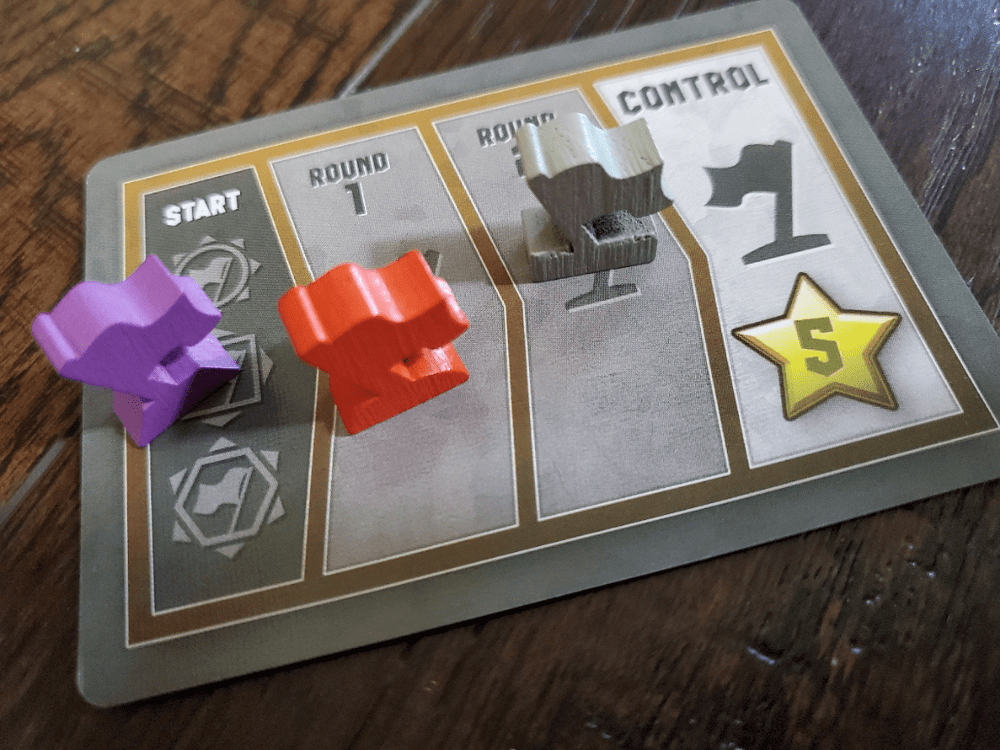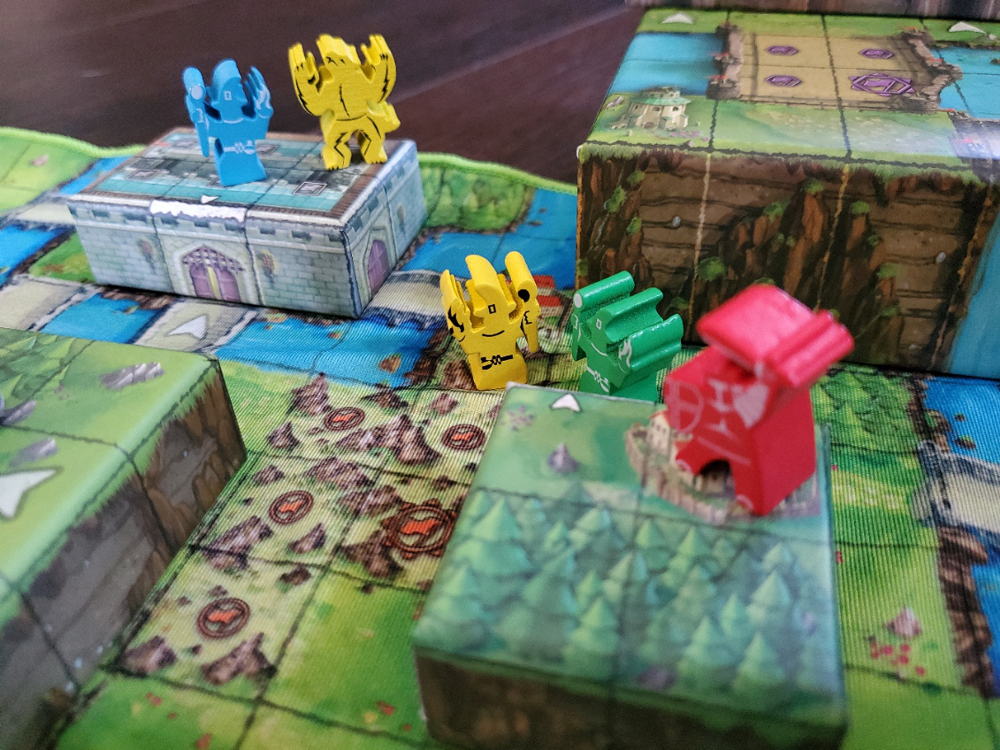Disclosure: Meeple Mountain received a free copy of this product in exchange for an honest, unbiased review. This review is not intended to be an endorsement.
A 3D map made of stackable boxes. That was the selling point for me on Tiny Epic Tactics. When trying to figure out how much can be accomplished with a fixed box of diminutive proportions, who thinks to include a layer of terrain boxes nested inside the game box? Two-sided terrain boxes? Scott Almes, that’s who. The Gamelyn Games team repeatedly seeks out ways to make you say, “Huh, well I’ll be…” upon opening the next Tiny Epic title. Tactics is no different.
Tiny Epic Tactics (just Tactics hereafter) is a skirmish game with more modes than you can shake a stick at for one to four players. I’ll provide the most detail for the base competitive mode, but I’ll touch on the others as well.
Basic Training
The nested boxes are arranged atop a stitched cloth map base to form a 3D realm upon which players battle—mostly for blood and area majorities. The terrain then includes high and low ground, water and bridges, forests and peaks, villages and portals. Oh, and one ballista for that extra panache.

Players take up a team of four characters—Units, in the game’s parlance—to enter the struggle: Wizard, Beast, Rogue, and Fighter, each represented by a meeple and an identifying card. With three actions per turn, players move, fight (melee and range), and cast spells. The key feature here is Weakness. If any Unit takes more than one action (though never the same action twice), it becomes Weakened and remains so through the next turn unless the player wishes to suffer two damage. This little annoyance forces a strategy that includes a bit of forethought and every available Unit.
Movement corresponds to a number on the Unit’s card and is then potentially altered by terrain. One extra movement to climb, to enter water, that sort of thing. There are portals across the map that allow instant passage to any other portal, which maintains the possibility of constant action. Passing through a village grants a boost of four health and refills mana and quivers for the ranged attackers.

Melee attacks dole out instant damage and are followed by a dice roll to determine knock-backs, which send the opposition flying. With a well-timed and positioned attack, these extra licks might add to the damage by pushing into a rock face or off the map’s edge.
Range attacks also feature a roll of the dice, but to determine efficiency. After spending one projectile point, the roll might reveal a number of misses that each also cost a point. If the player has points to cover their bad aim, the attack counts and the damage dished. The same rules apply for the Wizard, though the effects of Spells are varied depending on the character.
The one thing I forget to do most often when I play, Tactics, though, is Counter-attack. There are almost no printed references to Counter-attacking in sight during the game, but every time a character is attacked they can counter, provided they are in range. These counters are essential, and yet hard to remember until you’re familiar with the system. You’ve been warned.
Each turn ends with drawing a Tactic card. These cards form a rotating stock of if-then statements that might provide a boon if the conditions are right.
The Ends
There are two primary objectives in the competitive game, each tied to both the score and the endgame trigger. First, if a player’s team is entirely wiped out, it’s time to finish with a final round.
The second aim involves a series of flag tokens, earned by securing control of an area—at the opportune moment. There are three areas on the map marked by flag icons, with one space in each boasting a larger icon—the activation space. When a player’s turn begins with control of one of the areas (provided it has happened one time before with occupation of the activation space), the flag token moves up on its track. When the flag reaches its third space, the controlling player keeps the token, which is worth a hefty number of points at the end. Depending on the player count, securing a number of flags will trigger the end.

Scoring involves adding survivors, captured enemies, secured flags, and occupied villages. The player who best trampled their opponents is the winner.
Game modes! Get your game modes!
Are you more of a team player? Tactics has you covered with the necessary adjustments for a two-versus-two engagement. Would you rather play a free-for-all that involves custom map-building, cutthroat violence, and a single flag relic that folks pass along until they are knocked back from a melee attack? Well then check out Battle mode. Do you dig the sound of this free-for-all thing, but you’re still a team player? They’ve got you.
Are you a solo player? Then my goodness Tactics becomes a wholly different game altogether. Toss out the previous objectives and chase six dungeon crystals against the AI opponent. But it’s not just the objectives that change, those nested mini-boxes all contain grids and icons on the inside as well—dungeons in which to hunt the gems. When a Unit enters a portal, they can either transport to another space or hang a left in the tunnel somewhere, flip the box, and enter the darkness where random monsters, cave-ins, traps, magic barriers, and general dungeon-y features await.
The Deluxe edition also comes with a Lanterns expansion for those looking to add side-hustles to the mix. Players acquire torches when they pass through portals which they can then deliver to the villages to claim a lantern token.
Swing and a miss
The Kickstarter funded a set of expansion maps to shake up the Tactics realm. The Wastelands and the Winter Highlands begin with a new stitched map base—which is fine—and also a set of slip-on box covers—which are not fine.
The bottom line is this: the box covers have to be perfectly snug to work well. These are not. They are just loose enough in places that the cardboard flares out, causing some spaces below to be partially covered. Also, because they are not absolutely perfect, if a map were to include two mini-boxes side-by-side, they just can’t, so they take up an extra row on the grid because of the sloppy extra. They’re just not heavy enough to hold steady.

What I would love to see instead is another layer of nested boxes inside the main box. There is nearly room in the box depth as designed, and I believe it would have worked. I’m not nearly as concerned with a different color of terrain (white and tan) as I am with adding variety to the existing (predominantly green) setup. However, such a thing would also require making the boxes the right size to hold the components, which, at present, they are not. I think it could have worked, and worked well, scratching the deepest itches of the creative map-building types.
Climbing the fence
Tactics is a fun little game, but it definitely has its foibles. The 3D map is a super-cool idea, but it requires standing at times to see the valleys. Maybe this adds a bit of excitement to the game, but maybe it’s also a little annoying when you’ve elected to spend time in a region that requires standing on every turn.
I really enjoy that there are multiple paths to victory from a points perspective. Players can focus on gaining the flags and interrupting the flaggish pursuits of others. They can simply brawl it out and collect enemy Units like I collect board games. With Lanterns, they can hustle around the map picking up torches and helping villages. There are definitely things to do.
The mechanics feed the objectives and contribute to the stories. Melee knock-backs provide a one-two punch in the fight for area majorities. If a Rogue can get hold of a peaks space, which gives infinite range, they can issue damage all over the map as folks try to settle into cozy corners. The damage may not seem devastating, but eventually those Units will need to step away to visit a village. The extra movements to pull that off sometimes earn a Weakened token, which can alter a particular effort dramatically.

If I have a struggle, it’s that Tactics is almost too complex for what it seems like it should be. I applaud the pursuit of a startlingly robust experience, and I know that is the aim of the Tiny Epic line, but sometimes the appearance and experience are at odds with expected intuition and ease, and that creates a bit of a disconnect for me here.
As an example, the peaks spaces are printed on the boxes, granting infinite range. But if one Unit is standing in the square next to the peak, they are considered to be on the same level for range purposes, and adjacent for melee purposes? It’s a mountain. In a game with 3D bits, this seems odd. I already mentioned how frequently everyone forgot that they could counter-attack—maybe a player aid would have helped. In fact, a player aid would have helped with the entire game progression, including the maintenance of Weakened tokens. There is much to remember for so small a box.
I was playing Tactics at the same time I was reviewing Masters of the Universe: Clash for Eternia. The two games, despite occupying different dimensions (of scale, of course) actually scratch similar itches: taking a team into a Scenario of brawling, pick-up-and deliver, and tactical control. MotU is a sprawling beast on the table with a six-fold board, miniatures galore, extra set pieces, and bulky goodness everywhere. Tactics is, well, Tiny. Seeing the two in tandem reveals that the little guy is actually the more convoluted system. MotU, while littered with edge cases from all the character variety, is a silky-smooth core system that makes sense almost instantly out of the box. I think I spent more time in the rulebook for Tactics just grasping the basics…and there are still some edge cases to consider. The early plays stretched beyond the already-vague 30-60 minute estimate.
I do believe Tactics is an interesting exploration if you’re into skirmish games. There is a lot to celebrate in the varied modes, especially if you don’t have room for a game that encourages retail (and shelf) bloat. It’s not my favorite combat game, but I can get behind its more unique qualities, and I think you might enjoy seeing what’s possible with so little, especially if you have groups hunting for the variations in play.
I wouldn’t bother with the maps expansion, even though it means you’re limited in how you can configure the area control setup. The quality just isn’t there in my opinion. Lanterns, on the other hand, is a nice added touch and closer to a must-try.
From the first play I had a feeling I was climbing a fence. Much to see from the top, but little incentive to really get down on one side or the other.












Add Comment